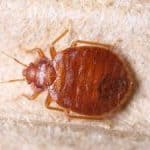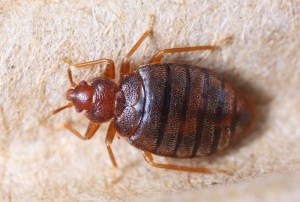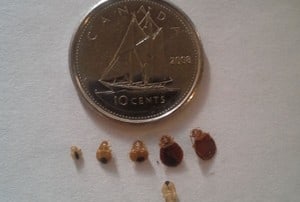Votre panier est actuellement vide !

Bedbugs
Flattened oval body without wings and measure 4 to 7 mm long.of brilliant brownish color, they inflate after a meal of blood and then take a dark brown coloring.
Latin Name: Cimex Lectularius
Description :
Flattened oval body without wings and measure 4 to 7 mm long. They are shiny brown and swell up after a blood meal, turning dark brown. There are three stages in the development cycle of the bug: egg, nymph and adult. The eggs are white and about 1 mm long. The nymph looks similar to the adult, but is smaller. When these insects are numerous, they produce a particular smell.
Reproduction:
When she lays her eggs, the female produces a substance that allows her to glue them in place. When it comes out of the egg, the young insect (larva) already has the shape of the adult but is smaller. Yellowish in color at first, it becomes more reddish after the first blood meal. It will develop gradually and to become an adult, it will have to take blood five times. Once mature, the male and female will mate and, after sucking blood once more, the female will lay her eggs. Bed bugs are gregarious; eggs, larvae and adults live together. Translated with www.DeepL.com/Translator (free version)
Egg production:
- 1 to 5 eggs per day per adult female
- Up to 500 eggs per female in her lifetime
- The eggs are fixed by a sticky secretion
- 6 to 10 days to hatch
Cycle of life:
- From egg to adult: 21 days at 30°C and 120 days at 16°C (relative humidity 75-80%)
- 5 nymphal stages requiring a blood meal to moult and pass to the next stage
- Life expectancy in normal conditions: 316 days
- 3 to 4 generations per year
Habits:
This insect is not always easy to detect, because it is mostly active at night. During the day, it hides near the seams of the mattress (even if it is a waterbed). When the infestation progresses or when humans or animals are no longer accessible, it disperses a little more. It can then be found in small cracks in walls and wood (such as bed frames, box springs, furniture, floors or door or window frames) where it will lay its eggs.
Bed bugs can also hide behind baseboards, under wallpaper or paintings. Although they spread less rapidly than cockroaches between apartments, they can follow pipes and travel between them and even between houses. Bedbugs do not stray far from their host if they can feed regularly, but if there is a large infestation, they may migrate to other rooms. The absence of prey leads to the dispersal of the bugs. Thus, when bedbugs are present in a single room with people who sleep there regularly, they will tend to stay there. However, if these people are removed from the room, the bedbugs will disperse throughout the dwelling or even elsewhere in the building. If not, they will walk from one room to the next on the floor.
Moving or moving already infested items (furniture, bedding, clothing, hotel suitcases, etc.) from one living area to another is the main way bedbugs are spread.
Development factors
- Minimum temperature for development: 13°C
- Lethal temperatures : Min : -16°C constant for 4 days. Max : 50°C for 3 hours.
- Much prefers human blood but would settle for a warm-blooded animal.
- Their meals take from 3 to 12 minutes.
- Under certain conditions, an adult bug can survive 1 year without feeding.
SYMPTOMS:
For most people, the bites will result in the formation of small reddish lesions that will develop into raised, hardened lesions. These lesions cause severe itching, are more symptomatic in the morning and the intensity of the redness and itching decreases during the day.
The lesions occur mainly on the exposed parts of the arms, legs and back.
If the person is not stung again, the lesions disappear after two weeks.
Prevention:
Infestation can be confirmed by finding live insects, molts, eggs or droppings in potential bedbug hiding places. The latter may also be visible as small black or dark brown spots on the sheets or mattress, often at the seams.vacuuming is a very effective way to remove bedbugs already present. Vacuuming is a very effective way to remove bedbugs that are already present. It is recommended to vacuum mattresses and box springs especially at the seams, folds and structures of infested beds.
If the outer shell of the mattress is torn, bedbugs may have gotten inside. If this is the case, it should be covered with a bedbug cover to prevent them from spreading.
You should also vacuum the floor and areas where you suspect bedbugs are hiding.
Be sure to dispose of the vacuum bag immediately without opening it in a place where bedbugs can disperse again.
TRAVELS:
If you sleep in an area that is frequented by many travelers, such as a hotel, you can lift the sheets to check for brown or black spots. Exuviae (old skins) that have been shed during molting can also be evidence of passage.
Treatment:
Depending on the degree of infestation, (to be inspected by an exterminator) treatments can be applied in the home but should be administered by specialists to ensure that all sources of infestation are eliminated. Integrated Pest Management (IPM) remains the best way to control this epidemic. The use of pesticides alone will not solve a bedbug problem. Be sure to contact an expert to get rid of this problem.
Improper use of pesticides creates displacement and resistance in treated populations and can even harm your health. Never throw away infested furniture, it can be treated. If you still want to dispose of it, you must destroy it and make it unusable. Bedding (pillowcases, sheets, mattress covers, etc.) and clothing should be washed with hot water and soap. Bedding should be placed directly into the washer from a plastic bag to prevent the spread of bedbugs in the laundry room and elsewhere in the building.
Once washed, bedding can be put back on a mattress that has been treated with steam or pyrethrins, but it is recommended that it be covered with bedbug covers. The rest of the clothes cannot be put back in drawers or closets and everything must be put back in a sealed plastic bag to avoid recontamination. This process must be followed until the treatment is completed and the bedbugs are eliminated.


